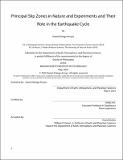Principal Slip Zones in Nature and Experiments and Their Role in the Earthquake Cycle
Author(s)
Ortega-Arroyo, Daniel
DownloadThesis PDF (18.05Mb)
Advisor
Peč, Matěj
Terms of use
Metadata
Show full item recordAbstract
Earthquakes generally do not occur in intact rocks but rather within extremely narrow (≤10 cm) principal slip zones found along fault zones. These slip zones are relatively weaker than the surrounding wall rocks suggesting they play an important through the earthquake cycle. This thesis explores the microphysical processes occurring along principal slip zones and examines their influence in fault behavior from various perspectives and scales. Chapter 2 examines slickensides from three different fault systems, using laser profilometry to measure fault surface roughness and detailed microstructural analyses to identify the processes leading to these structures. Chapter 3 presents stick-slip experiments aimed at understanding the energy flow during earthquakes, quantifying the complete energy budget of individual events through a combination of microstructural analyses, novel magnetic field imaging, ultrasonic probing and numerical modelling. Chapter 4 involves Differential Scanning Calorimetry (DSC) measurements on ball-milled granite powders to investigate how extreme grain size reduction affects earthquake processes. Lastly, Chapter 5 presents DSC measurements of pseudotachylites aimed at constraining the thermal history of past slip-events. Results from this thesis highlight that the strain path significantly influences how the energy flows during the earthquake cycle, underscoring the importance of microstructural evolution in determining bulk sample behavior.
Date issued
2025-05Department
Massachusetts Institute of Technology. Department of Earth, Atmospheric, and Planetary SciencesPublisher
Massachusetts Institute of Technology